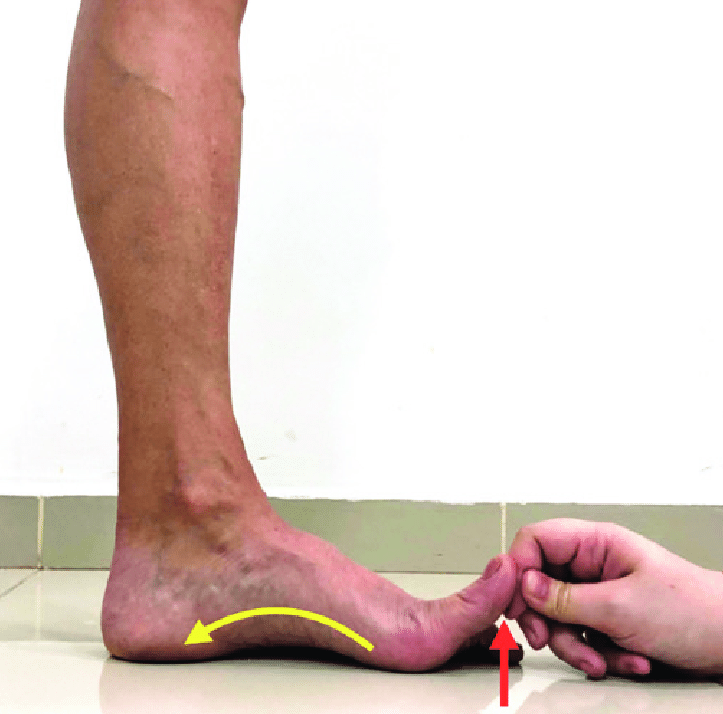The Hidden Key to Foot Function: The Importance of Big Toe Flexion in Foot Pain and Gait
When it comes to foot pain, most people don’t think twice about their big toe. But this small part of the body plays a surprisingly big role in how we walk, move, and stay pain-free. If your big toe isn’t working properly—especially when it comes to bending (flexion)—it can affect your entire walking pattern and lead to long-term discomfort.
Checking Big Toe Flexion Whilst Weight-Bearing. - Stiff Big Toe flexion whilst weight-bearing resulting in failed ‘windlass mechanism’. Patient attended the clinic due to pain in the heel(s).
What Does the Big Toe Actually Do?
Each time you take a step, your big toe helps push your body forward. It bends and presses against the ground as your heel lifts, helping with balance, stability, and momentum. In fact, your big toe handles about 40% of your body weight during the push-off phase of walking.
If that toe can’t bend properly, other parts of your foot—and even your knees, hips, and back—have to work harder to compensate.
Windlass Mechanism - Primary function of the Big Toe in foot function
The Big Toe’s Secret Weapon: The Windlass Mechanism
The big toe plays a key role in activating a built-in support system in your foot called the windlass mechanism.
Think of the bottom of your foot like a strong but flexible bridge. There’s a thick band of tissue underneath your foot called the plantar fascia, which connects your heel to your toes. When you take a step and your big toe bends upward, it pulls on this band of tissue. This tightens the arch of your foot, helping it become firm and supportive—just like tightening the laces on a shoe.
This tightening effect:
Raises your foot’s arch
Makes your step more efficient
Helps prevent your foot from flattening out too much
Reduces stress on muscles and joints further up the leg
If your big toe doesn’t bend properly, this whole system doesn’t work the way it should. That can lead to problems like flat feet, arch pain, heel pain (including plantar fasciitis), or poor walking mechanics over time
Correct Windlass Mechanics of the foot
Signs Your Big Toe Might Be the Problem
You might not realise your big toe is restricted, but here are some common signs:
You feel pain under the ball of your foot or in your arch
You have trouble pushing off the ground while walking or running
Your shoes wear out faster on one side
You walk with your feet turned outward
You’ve developed heel pain or plantar fasciitis
Research has shown that limited big toe movement can change how pressure is distributed through your foot, which can increase the risk of injuries like bunions, stress fractures, or tendon pain (Cheung et al., 2006; Ueki et al., 2021).
Why Does This Happen?
There are a few common reasons why your big toe might lose its normal motion:
Stiff joints from old injuries or arthritis
Poor footwear (tight shoes or unsupportive soles)
Lack of muscle strength in the small foot muscles
Walking mechanics that cause uneven loading over time
Even subtle issues can throw off your movement pattern without you noticing—until pain starts to creep in.
What Can You Do About It?
Here are a few simple things you can start doing to support better big toe function and relieve foot pain:
Check Your Toe Movement
Try bending your big toe downward while keeping your heel flat on the ground. If it’s stiff or painful, that’s a sign something isn’t working well.Strengthen Your Foot Muscles
Exercises like towel scrunches (gripping a towel with your toes) or picking up marbles can help activate the muscles that support your big toe.Choose the Right Shoes
Look for shoes with a wide toe box, a supportive sole, and enough flexibility through the forefoot to let your toes move naturally.See a Podiatrist
A podiatrist can assess your walking pattern and foot structure and recommend treatments like custom orthotics, manual therapy, or specific rehabilitation exercises. Studies support that these approaches can improve alignment, reduce pain, and restore normal movement (Barton et al., 2009).
Final Thoughts
Your big toe might be small, but it has a big job. If it’s not moving properly, your entire body may be paying the price. Whether you’re an athlete, on your feet all day, or just dealing with nagging foot pain—don’t ignore your big toe.
Taking simple steps to improve its movement can lead to better posture, less pain, and a smoother, healthier walk.
References
Barton, C. J., Bonanno, D., Levinger, P., & Menz, H. B. (2009). Foot orthoses for prevention of lower limb overuse injuries. British Journal of Sports Medicine, 42(11), 871–880.
Cheung, J. T., Zhang, M., & An, K. N. (2006). Effect of plantar fascia stiffness on the ankle-foot complex. Clinical Biomechanics, 21(2), 194–203.
Ueki, Y., et al. (2021). Foot posture and pressure-related forefoot pain. Journal of Foot and Ankle Research, 14(1), 13.
